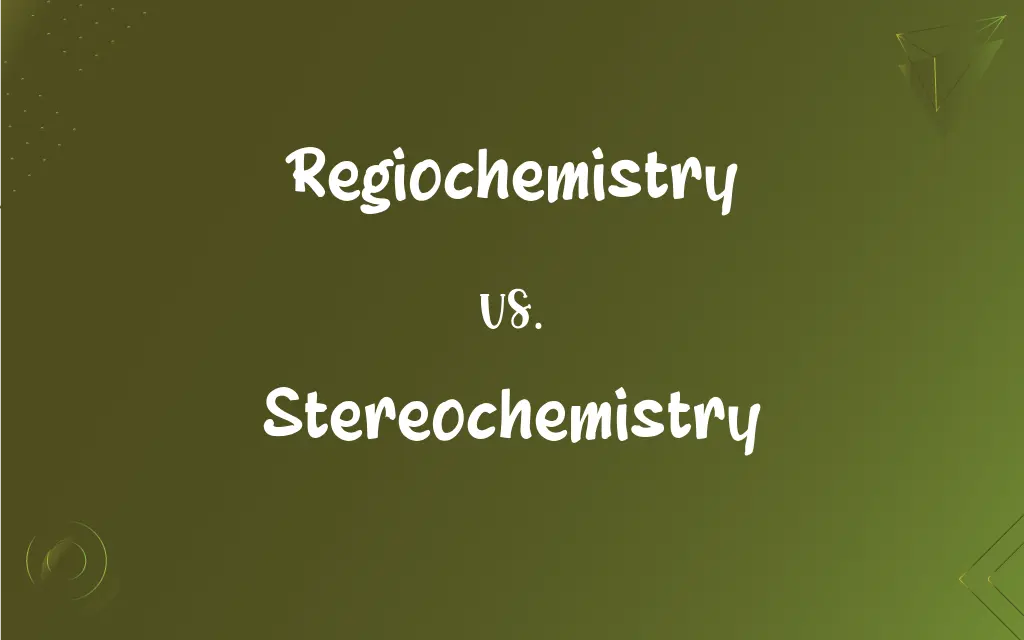Regiochemistry vs. Stereochemistry: What's the Difference?
Edited by Janet White || By Harlon Moss || Updated on October 23, 2023
Regiochemistry concerns which position on a molecule a reaction occurs, while stereochemistry pertains to the spatial arrangement of atoms.

Key Differences
Regiochemistry deals with the orientation of substituents or reagents on a molecule, specifically determining where they attach or add during a chemical reaction. In reactions where there are multiple positions for a reagent to attach, the regiochemical outcome can differ.
Stereochemistry, on the other hand, dives into the three-dimensional arrangement of atoms in a molecule. Rather than focusing on where a bond occurs like regiochemistry, stereochemistry emphasizes how atoms are oriented in space, considering configurations like cis/trans or E/Z, and R/S enantiomers.
A simple way to distinguish regiochemistry from stereochemistry is to consider a reaction involving an unsymmetrical alkene. While regiochemistry would be concerned with which carbon the reagent attaches to (Markovnikov vs. anti-Markovnikov), stereochemistry would consider the spatial positioning of the attached groups.
It's noteworthy that both regiochemistry and stereochemistry can play crucial roles in the outcome of reactions. A particular reaction might exhibit regioselectivity, favoring one region over another, or stereoselectivity, favoring one stereoisomer over another.
Understanding the intricacies of both regiochemistry and stereochemistry is essential for chemists. Mastery in these areas ensures that desired compounds are synthesized with precision, especially in industries like pharmaceuticals where the correct structure is vital.
ADVERTISEMENT
Comparison Chart
Definition
Deals with where reactions occur on molecules.
Concerns the spatial arrangement of atoms in molecules.
Focus
Position of attachment during reactions.
Three-dimensional orientation of atoms.
Relevance
Determines which carbon or position a reagent adds to.
Specifies configurations like cis/trans or R/S enantiomers.
Selectivity Type
Regioselectivity
Stereoselectivity
Importance in Synthesis
Ensures reactions occur at the right position on molecules.
Ensures correct spatial arrangement for desired molecular properties.
ADVERTISEMENT
Regiochemistry and Stereochemistry Definitions
Regiochemistry
Concerned with the preferred site of reactivity in a molecule.
The regiochemistry of the hydroboration reaction is anti-Markovnikov.
Stereochemistry
Pertains to the three-dimensional orientation of molecular constituents.
The stereochemistry of the double bond was cis.
Regiochemistry
The study of how substituents or reagents add to specific regions of a molecule.
The regiochemistry of the addition determined that the bromine attached to the more substituted carbon.
Stereochemistry
The study of spatial arrangements of atoms in molecules.
The stereochemistry of the molecule was determined to be R-configured.
Regiochemistry
Dictates the location of bond formation on an unsymmetrical molecule.
The regiochemistry of the reaction was influenced by the electron-donating group.
Stereochemistry
Directs the specific geometric arrangement of a molecule's components.
The stereochemistry was vital for the drug's mechanism of action.
Regiochemistry
Determines the orientation of reagents on a molecular framework.
The catalyst affected the regiochemistry of the addition reaction.
Stereochemistry
Deals with molecular configurations and conformations.
The stereochemistry of the compound affected its biological activity.
Regiochemistry
Guides where a chemical reaction predominantly or exclusively occurs.
The regiochemistry of the reaction was consistent with electronic factors.
Stereochemistry
Describes the spatial relationships between atoms or groups in a molecule.
Changing the stereochemistry of one chiral center led to a different compound.
Regiochemistry
(chemistry) The chemistry of regioselective reactions
Stereochemistry
The branch of chemistry that deals with spatial arrangements of atoms in molecules and the effects of these arrangements on the chemical and physical properties of substances.
Stereochemistry
The branch of chemistry that involves the spatial arrangement of the atoms of molecules, and studies how this affects the physical and chemical properties of such species
Stereochemistry
The effect of such spatial arrangement on the chemistry of a particular compound
FAQs
How does regiochemistry impact addition to unsymmetrical alkenes?
It dictates whether addition occurs at the more or less substituted carbon.
What is the primary concern of stereochemistry?
Stereochemistry revolves around the spatial arrangement of atoms in molecules.
Can both regiochemistry and stereochemistry affect a single reaction?
Yes, a reaction might have both regioselective and stereoselective outcomes.
What are enantiomers in stereochemistry?
Enantiomers are mirror-image molecules that are non-superimposable.
How do cis and trans relate to stereochemistry?
They are descriptors of geometric isomerism based on spatial positions of substituents.
Are there tools to analyze regiochemistry and stereochemistry?
Yes, techniques like NMR spectroscopy can help determine both.
What's the relevance of regiochemistry in polymer science?
It can dictate polymer structure, influencing properties like strength or flexibility.
Can regiochemistry and stereochemistry influence molecular properties?
Absolutely, they can affect attributes like reactivity, boiling point, and biological activity.
Why is stereochemistry crucial in nature?
Many biological molecules, like enzymes, are chiral and interact differently with different stereoisomers.
What's an example of a reaction with regiochemical concerns?
Electrophilic aromatic substitution reactions have regiochemical preferences based on directing groups.
How do diastereomers relate to stereochemistry?
Diastereomers are stereoisomers that aren't mirror images, having different physical properties.
Are there theories guiding regiochemistry?
Yes, principles like Markovnikov's rule provide predictions for certain reactions.
What is the significance of stereochemistry in drug design?
Stereochemistry can influence a drug's efficacy and safety, as different stereoisomers can have different effects.
Does regiochemistry affect isomer count?
Yes, different regiochemical outcomes can lead to distinct isomers.
How are chiral centers related to stereochemistry?
Chiral centers, atoms with non-superimposable mirror images, are central to stereochemical considerations.
Is regiochemistry always predictable?
Often, but not always. Some reactions might have unexpected regiochemical outcomes.
What's a common stereochemical concern in organic reactions?
Ensuring the desired stereoisomer is formed without unwanted isomers.
What does regiochemistry focus on?
Regiochemistry is about where on a molecule a reaction occurs.
Can molecules have multiple chiral centers?
Yes, and the number of stereochemical isomers increases with more chiral centers.
How can chemists control regiochemistry?
Through the choice of reagents, catalysts, or reaction conditions.
About Author
Written by
Harlon MossHarlon is a seasoned quality moderator and accomplished content writer for Difference Wiki. An alumnus of the prestigious University of California, he earned his degree in Computer Science. Leveraging his academic background, Harlon brings a meticulous and informed perspective to his work, ensuring content accuracy and excellence.
Edited by
Janet WhiteJanet White has been an esteemed writer and blogger for Difference Wiki. Holding a Master's degree in Science and Medical Journalism from the prestigious Boston University, she has consistently demonstrated her expertise and passion for her field. When she's not immersed in her work, Janet relishes her time exercising, delving into a good book, and cherishing moments with friends and family.































































